News
-
.jpg&fileext=jpg&filetype=image/jpeg&filesize=366360) Join the Busan Hangeul School mentorship Program!
Busan Hangeul School is looking for participants for its Hangul (Korean Alphabet) Learning Support Mentor-Mentee Program!▶ When: Oct 27 (Mon) to Nov 21 (Fri), 4 weeks▶ Who: (Mentees) International students living in Busan / (Mentors) Busan residents▶ What: Personalized Hangul learning support for mentees▶ Perks: Mentors receive 10,000 KRW after submitting one activity report▶ Apply by: Oct 16 (Thu)ㅁ★Apply Now : https://m.site.naver.com/1H5Bz
Join the Busan Hangeul School mentorship Program!
Busan Hangeul School is looking for participants for its Hangul (Korean Alphabet) Learning Support Mentor-Mentee Program!▶ When: Oct 27 (Mon) to Nov 21 (Fri), 4 weeks▶ Who: (Mentees) International students living in Busan / (Mentors) Busan residents▶ What: Personalized Hangul learning support for mentees▶ Perks: Mentors receive 10,000 KRW after submitting one activity report▶ Apply by: Oct 16 (Thu)ㅁ★Apply Now : https://m.site.naver.com/1H5Bz
-
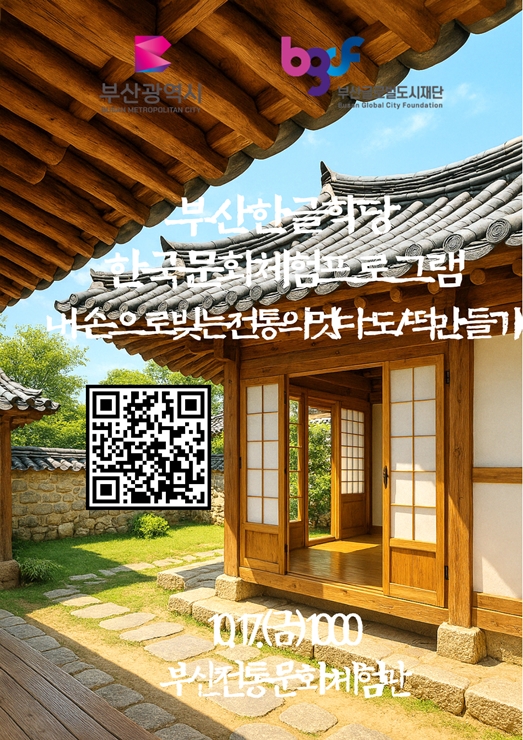 Enjoy Korean culture at Busan Hangeul School!
The Busan Global City Foundation is a public organization that operates various programs and exchange activities to help foreign residents in Busan adapt to local life and build a stable living environment.░ Busan Hangeul School – Korean Cultural Experience Program (Session 3)☑ Date & Time: Friday, October 17, 2025, 10:00 AM – 12:00 PM (2 hours)☑ Venue: Busan Traditional Culture Experience Center(71, Kkotmaeul-ro 163beon-gil, Seo-gu, Busan)☑ Participants: 40 international students residing in Busan☑ Program: Korean tea ceremony experience (learning traditional etiquette) / rice cake making / cultural talk & tasting☑ Participation Fee: Free of charge☑ Application Period: First-come, first-served★Apply Now : https://forms.gle/9W6psK7gt8bs7BoMA ░ Busan Hangeul School – Korean Cultural Experience Program (Session 4)☑ Date & Time: Saturday, October 25, 2025, 9:00 AM – 6:00 PM (9 hours)☑ Meeting Point: Busan Station☑ Participants: 40 international students residing in Busan☑ Program: Busan Highlight Tour (Songdo Marine Cable Car / Haedong Yonggungsa Temple / Gijang Gongsu Fishing Village / Yacht Experience)☑ Participation Fee: 15,000 KRW per person☑ Application Period: First-come, first-served★Apply Now : https://forms.gle/4QiRnYxvVpMSMj587
Enjoy Korean culture at Busan Hangeul School!
The Busan Global City Foundation is a public organization that operates various programs and exchange activities to help foreign residents in Busan adapt to local life and build a stable living environment.░ Busan Hangeul School – Korean Cultural Experience Program (Session 3)☑ Date & Time: Friday, October 17, 2025, 10:00 AM – 12:00 PM (2 hours)☑ Venue: Busan Traditional Culture Experience Center(71, Kkotmaeul-ro 163beon-gil, Seo-gu, Busan)☑ Participants: 40 international students residing in Busan☑ Program: Korean tea ceremony experience (learning traditional etiquette) / rice cake making / cultural talk & tasting☑ Participation Fee: Free of charge☑ Application Period: First-come, first-served★Apply Now : https://forms.gle/9W6psK7gt8bs7BoMA ░ Busan Hangeul School – Korean Cultural Experience Program (Session 4)☑ Date & Time: Saturday, October 25, 2025, 9:00 AM – 6:00 PM (9 hours)☑ Meeting Point: Busan Station☑ Participants: 40 international students residing in Busan☑ Program: Busan Highlight Tour (Songdo Marine Cable Car / Haedong Yonggungsa Temple / Gijang Gongsu Fishing Village / Yacht Experience)☑ Participation Fee: 15,000 KRW per person☑ Application Period: First-come, first-served★Apply Now : https://forms.gle/4QiRnYxvVpMSMj587
-
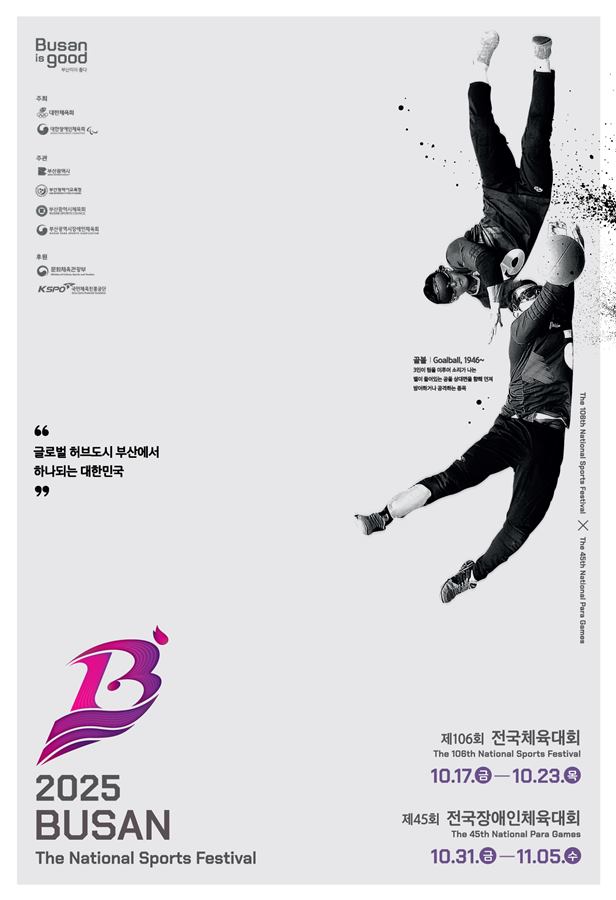 Busan to host the nation's biggest sports festival
In October, Busan will be filled with the fierce and heart-pumping spirit of competition as it hosts the 106th National Sports Festival and the 45th National Para Games. It has been 25 years since Busan last hosted the National Sports Festival, and the event’s return to the city will see a record number of participants.According to the Korean Sport & Olympic Committee, the festival will welcome 28,791 participants from 17 metropolitan cities and provinces nationwide, including 19,418 athletes (12,354 men and 7,064 women) and 9,373 officials.Additionally, Korean sports organizations operating overseas will send a 1,515-member delegation comprising athletes and officials from 18 countries. With more than 4,200 volunteers on board, Busan has prepared extensively to ensure smooth operations, reflecting both the city’s commitment and its citizens’ passion for this significant event. Athletes will compete in 48 events, with an additional two events, foot volleyball and jiu-jitsu, featured as demonstration sports. Each event will include four categories: under-18, university, overseas Koreans and general.Following the National Sports Festival, the 45th National Para Games will take place from Oct. 31 to Nov. 5, featuring 31 sports across 38 venues throughout the city.<Today's Vocabulary - 오늘의 단어>fierce: 맹렬한 delegation: 대표단 athlete: 운동선수 extensively: 광범위하게 venue: 장소Editor: Song SoomiCopy Editors: Ryu Hyoseung, Anton J. Mapoy
Busan to host the nation's biggest sports festival
In October, Busan will be filled with the fierce and heart-pumping spirit of competition as it hosts the 106th National Sports Festival and the 45th National Para Games. It has been 25 years since Busan last hosted the National Sports Festival, and the event’s return to the city will see a record number of participants.According to the Korean Sport & Olympic Committee, the festival will welcome 28,791 participants from 17 metropolitan cities and provinces nationwide, including 19,418 athletes (12,354 men and 7,064 women) and 9,373 officials.Additionally, Korean sports organizations operating overseas will send a 1,515-member delegation comprising athletes and officials from 18 countries. With more than 4,200 volunteers on board, Busan has prepared extensively to ensure smooth operations, reflecting both the city’s commitment and its citizens’ passion for this significant event. Athletes will compete in 48 events, with an additional two events, foot volleyball and jiu-jitsu, featured as demonstration sports. Each event will include four categories: under-18, university, overseas Koreans and general.Following the National Sports Festival, the 45th National Para Games will take place from Oct. 31 to Nov. 5, featuring 31 sports across 38 venues throughout the city.<Today's Vocabulary - 오늘의 단어>fierce: 맹렬한 delegation: 대표단 athlete: 운동선수 extensively: 광범위하게 venue: 장소Editor: Song SoomiCopy Editors: Ryu Hyoseung, Anton J. Mapoy
Enjoy Busan
-
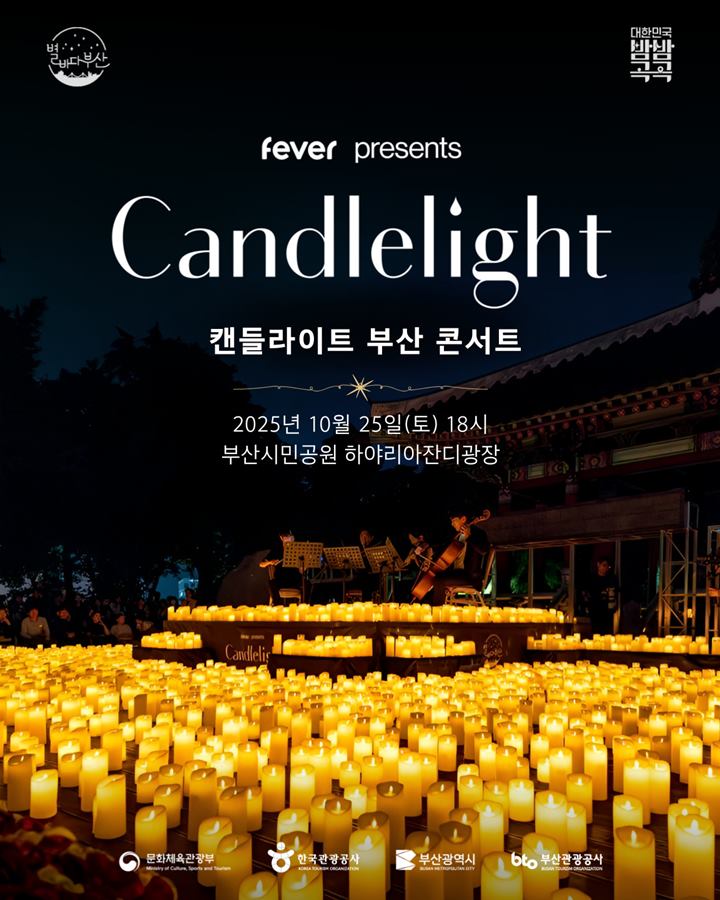.jpg&fileext=jpg&filetype=image/jpeg&filesize=99043) Free Candlelight Busan Concert brings warmth on a cool evening
source: visitbusanOn Oct. 25, people of all ages are invited to spend a cozy night out with the Candlelight Busan Concert. Experience an evening of beautiful melodies while picnicking in the cool autumn air at Hialeah Lawn Plaza at Busan Citizens Park – completely free of charge!The popular Candlelight concert series draws audiences worldwide with its unique mix of spectacular venues, romantic atmosphere and curated selection of classical music.Taking center stage is Risus Quartet, a rising string group that made headlines as the first Korean ensemble to win the grand prize at the Fischoff National Chamber Music Competition (2021 – USA). They’ll be performing fan-favorite pieces by Joe Hisaishi and Kwang-seok Kim, making it a must-see event for classical music fans and anyone who loves emotional film scores and iconic Korean melodies.The performance runs for about 65 minutes, and seating is first-come, first-served. Since it’s an outdoor lawn event, guests should bring their own mats and blankets. Camping chairs and tables with legs are strictly prohibited to protect the park grounds.The event will be filmed and photographed, so by attending, you’re agreeing to possibly being on camera.For updates or additional details, check out the Visit Busan website or follow Starry Night Busan on Instagram.※ Candlelight Busan Concert, 6 p.m. on Oct. 25 ◎ Busan Citizens Park: 73 Simingongwon-ro, Busanjin-gu◎ Website: Click◎ Instagram: @starry_night_busan.kr, @starry_night_busan.en <Today's Vocabulary - 오늘의 단어>draw: 끌어 모으다 audience: 관객 atmosphere: 분위기 lawn: 잔디 Editor: Song SoomiCopy Editors: Ryu Hyoseung, Anton J. Mapoy
Free Candlelight Busan Concert brings warmth on a cool evening
source: visitbusanOn Oct. 25, people of all ages are invited to spend a cozy night out with the Candlelight Busan Concert. Experience an evening of beautiful melodies while picnicking in the cool autumn air at Hialeah Lawn Plaza at Busan Citizens Park – completely free of charge!The popular Candlelight concert series draws audiences worldwide with its unique mix of spectacular venues, romantic atmosphere and curated selection of classical music.Taking center stage is Risus Quartet, a rising string group that made headlines as the first Korean ensemble to win the grand prize at the Fischoff National Chamber Music Competition (2021 – USA). They’ll be performing fan-favorite pieces by Joe Hisaishi and Kwang-seok Kim, making it a must-see event for classical music fans and anyone who loves emotional film scores and iconic Korean melodies.The performance runs for about 65 minutes, and seating is first-come, first-served. Since it’s an outdoor lawn event, guests should bring their own mats and blankets. Camping chairs and tables with legs are strictly prohibited to protect the park grounds.The event will be filmed and photographed, so by attending, you’re agreeing to possibly being on camera.For updates or additional details, check out the Visit Busan website or follow Starry Night Busan on Instagram.※ Candlelight Busan Concert, 6 p.m. on Oct. 25 ◎ Busan Citizens Park: 73 Simingongwon-ro, Busanjin-gu◎ Website: Click◎ Instagram: @starry_night_busan.kr, @starry_night_busan.en <Today's Vocabulary - 오늘의 단어>draw: 끌어 모으다 audience: 관객 atmosphere: 분위기 lawn: 잔디 Editor: Song SoomiCopy Editors: Ryu Hyoseung, Anton J. Mapoy
-
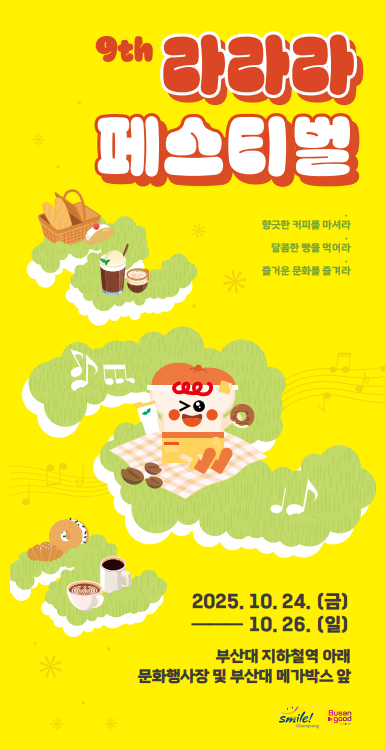 Spend the weekend at the 9th Lalala Festival
The 9th Lalala Festival will take place from Oct. 24 to 26 in the area around Busan National University. The beloved event combines coffee, music and activities in the crisp autumn air.This year’s event will feature local and national coffee, dessert and bakery brands selling their treats to festivalgoers. Visitors can also enjoy an open-air market, experience booths, coffee tasting, crafts making, sports and live performances.The festival runs from 2 to 8 p.m. on Oct. 24, and 11 a.m. to 8 p.m. on the weekend.※ Lalala Festival, Oct. 24 to 26◎ Location: Busan National University Station (Metro Line 1)<Today's Vocabulary - 오늘의 단어>combine: 합치다 feature: 특징으로 하다 craft 수공예품Editor: Song SoomiCopy Editors: Ryu Hyoseung, Anton J. Mapoy
Spend the weekend at the 9th Lalala Festival
The 9th Lalala Festival will take place from Oct. 24 to 26 in the area around Busan National University. The beloved event combines coffee, music and activities in the crisp autumn air.This year’s event will feature local and national coffee, dessert and bakery brands selling their treats to festivalgoers. Visitors can also enjoy an open-air market, experience booths, coffee tasting, crafts making, sports and live performances.The festival runs from 2 to 8 p.m. on Oct. 24, and 11 a.m. to 8 p.m. on the weekend.※ Lalala Festival, Oct. 24 to 26◎ Location: Busan National University Station (Metro Line 1)<Today's Vocabulary - 오늘의 단어>combine: 합치다 feature: 특징으로 하다 craft 수공예품Editor: Song SoomiCopy Editors: Ryu Hyoseung, Anton J. Mapoy
-
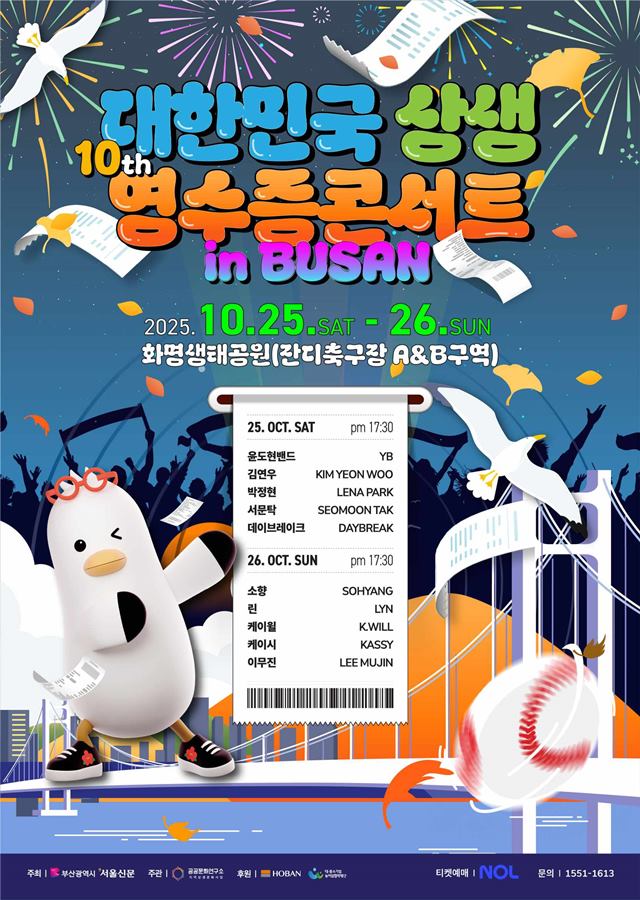대한민국상생영수증콘서트in부산.jpg&fileext=jpg&filetype=image/jpeg&filesize=127626) Unique festival turns everyday spending into concert tickets
The 2025 Korea Win-Win Bill Concert in Busan (2025 대한민국 상생 영수증 콘서트 in Busan) will take place on Oct. 25 and 26 at Hwamyeong Eco Park. True to its name, this event adds a creative twist to the traditional festival model, allowing receipts worth over 100,000 won, issued by local establishments in Busan, to serve as concert tickets. The concert series offers a unique experience that transforms local consumption into cultural participation, creating a mutually beneficial opportunity for residents and local small business owners.Tickets are priced at 10,000 won and available online through NOL Interpark. In addition to purchasing a ticket, submission of a qualifying receipt is mandatory for every participant. Festivalgoers are encouraged to register their receipts in advance via the official KakaoTalk channel linked below, though on-site registration will also be available. Receipts must meet the following conditions:- Total expenditure exceeding 100,000 won- Issued by local stores and eateries located in Busan (receipts from department stores, franchise supermarkets or local branches of national chains are excluded)- Valid for purchases made between Sept. 9 and the concert datesParticipants will also receive an on-site voucher worth 10,000 won as a ticket reimbursement, which can be used at the flea market or food trucks within the venue. The concerts begin at 5:30 p.m. on both days. On Oct. 25, audiences can enjoy powerful performances by YB, Daybreak, Jung-hyun (Lena) Park, Yeon-woo Kim and Moon-tak Seo. The following day will feature a lineup of beloved solo acts, including Mujin Lee, Lyn, Sohyang, K.Will and Kassy, setting the stage for a romantic evening. There will be no designated seating, so participants are welcome to bring picnic mats and choose their own spots. As the evening may get chilly, bringing warm items such as a blanket or jacket is recommended. Please take note that tents, tables and chairs with legs are strictly prohibited. For more details, please visit the official website linked below. ※ 2025 Korea Win-Win Bill Concert in Busan, Oct. 25-26◎ Hwamyeong Eco Park: 1718-17 Hwamyeong-dong, Buk-gu◎ Website: Click ◎ Tickets: Click ◎ Pre-registration for qualifying receipts: Click <Today's Vocabulary - 오늘의 단어>consumption: 소비 receipt: 영수증 mandatory: 의무적인 designated: 지정된 prohibit: 금지하다Editor: Song SoomiCopy Editors: Ryu Hyoseung, Anton J. Mapoy
Unique festival turns everyday spending into concert tickets
The 2025 Korea Win-Win Bill Concert in Busan (2025 대한민국 상생 영수증 콘서트 in Busan) will take place on Oct. 25 and 26 at Hwamyeong Eco Park. True to its name, this event adds a creative twist to the traditional festival model, allowing receipts worth over 100,000 won, issued by local establishments in Busan, to serve as concert tickets. The concert series offers a unique experience that transforms local consumption into cultural participation, creating a mutually beneficial opportunity for residents and local small business owners.Tickets are priced at 10,000 won and available online through NOL Interpark. In addition to purchasing a ticket, submission of a qualifying receipt is mandatory for every participant. Festivalgoers are encouraged to register their receipts in advance via the official KakaoTalk channel linked below, though on-site registration will also be available. Receipts must meet the following conditions:- Total expenditure exceeding 100,000 won- Issued by local stores and eateries located in Busan (receipts from department stores, franchise supermarkets or local branches of national chains are excluded)- Valid for purchases made between Sept. 9 and the concert datesParticipants will also receive an on-site voucher worth 10,000 won as a ticket reimbursement, which can be used at the flea market or food trucks within the venue. The concerts begin at 5:30 p.m. on both days. On Oct. 25, audiences can enjoy powerful performances by YB, Daybreak, Jung-hyun (Lena) Park, Yeon-woo Kim and Moon-tak Seo. The following day will feature a lineup of beloved solo acts, including Mujin Lee, Lyn, Sohyang, K.Will and Kassy, setting the stage for a romantic evening. There will be no designated seating, so participants are welcome to bring picnic mats and choose their own spots. As the evening may get chilly, bringing warm items such as a blanket or jacket is recommended. Please take note that tents, tables and chairs with legs are strictly prohibited. For more details, please visit the official website linked below. ※ 2025 Korea Win-Win Bill Concert in Busan, Oct. 25-26◎ Hwamyeong Eco Park: 1718-17 Hwamyeong-dong, Buk-gu◎ Website: Click ◎ Tickets: Click ◎ Pre-registration for qualifying receipts: Click <Today's Vocabulary - 오늘의 단어>consumption: 소비 receipt: 영수증 mandatory: 의무적인 designated: 지정된 prohibit: 금지하다Editor: Song SoomiCopy Editors: Ryu Hyoseung, Anton J. Mapoy
Food
-
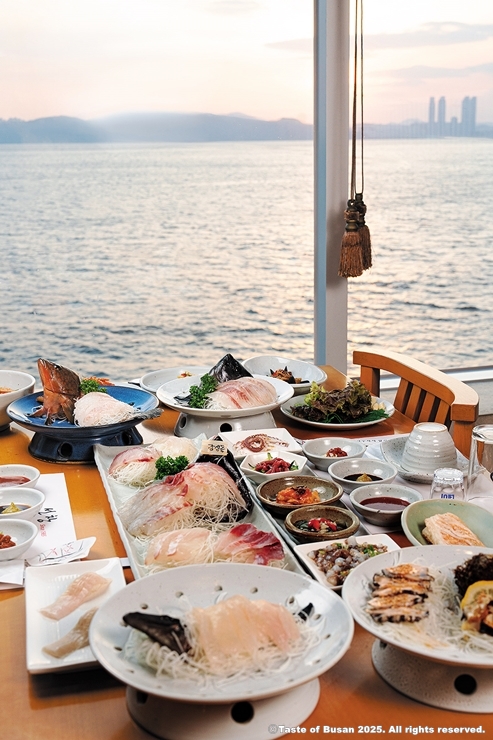 Eat your way through Busan
Food lovers, take note: Busan is a city that rewards curiosity. From bustling seafood markets to stylish bistros, the city offers an abundance of dining options. Across the city, diners will find hundreds of officially designated "Taste of Busan" establishments that promise high-quality meals at fair prices. At the higher end, Busan's culinary reputation is on the rise. The city's Michelin Guide features three one-star restaurants along with numerous Bib Gourmand and Selected listings, proof that Busan is a must-visit for gourmands. Busan offers so much more than fried chicken, barbecue and kimchi. Whether alone, with a date or with a mate, the city is best experienced with an open mind, an empty stomach and loose pants.■Taste of Busan 2025(click to download the guidebook)Enjoy fresh sashimi at Seonchang Hoetjip. Generous portions and toppings are standard at Lee Jaemo Pizza.Gamasot has been serving pork ribs for 30 years. ■Michelin Guide restaurant in Busan(Click to learn more)Palate(one-star)Fiotto(one-star and Green Star)Mori(one-star)
Eat your way through Busan
Food lovers, take note: Busan is a city that rewards curiosity. From bustling seafood markets to stylish bistros, the city offers an abundance of dining options. Across the city, diners will find hundreds of officially designated "Taste of Busan" establishments that promise high-quality meals at fair prices. At the higher end, Busan's culinary reputation is on the rise. The city's Michelin Guide features three one-star restaurants along with numerous Bib Gourmand and Selected listings, proof that Busan is a must-visit for gourmands. Busan offers so much more than fried chicken, barbecue and kimchi. Whether alone, with a date or with a mate, the city is best experienced with an open mind, an empty stomach and loose pants.■Taste of Busan 2025(click to download the guidebook)Enjoy fresh sashimi at Seonchang Hoetjip. Generous portions and toppings are standard at Lee Jaemo Pizza.Gamasot has been serving pork ribs for 30 years. ■Michelin Guide restaurant in Busan(Click to learn more)Palate(one-star)Fiotto(one-star and Green Star)Mori(one-star)
-
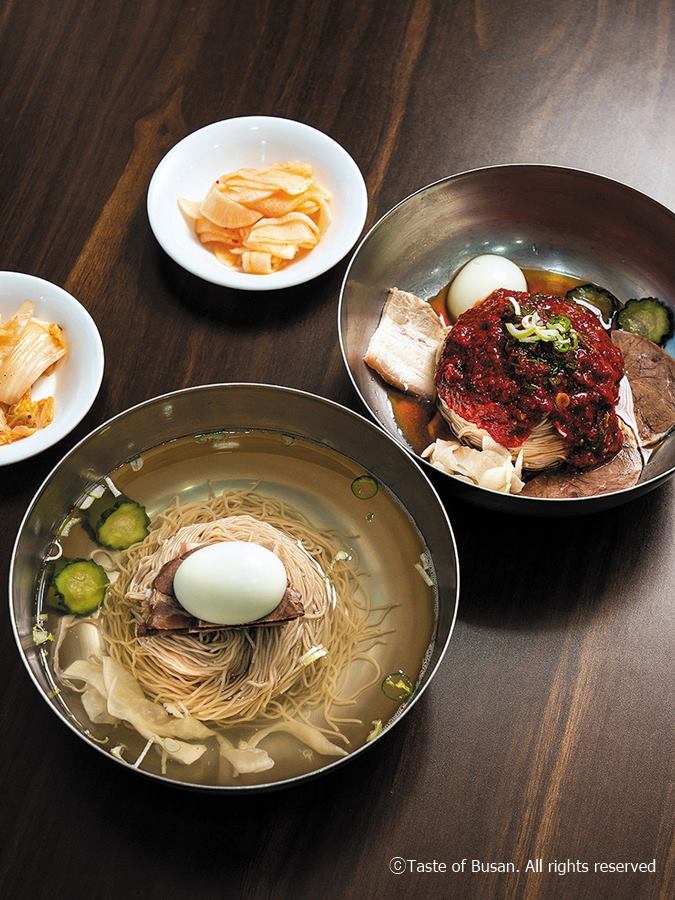 Bite Into Busan ③ Noodles
source: Taste of Busan"Bite Into Busan" is a monthly celebration of the city's restaurants. Each featured spot is listed in the Michelin Guide and Taste of Busan, the city's official gourmet guidebook, and is known for its signature dishes. This month, we take a long look at noodles. Across East Asia, they have evolved from humble, post-war staples to icons of cultural identity. Whether it's icy Korean naengmyeon, savory Japanese ramen or nourishing Taiwanese beef noodle soup, these dishes remind us how strands of dough can carry stories across borders and bring people together, one bowl at a time.🍜 Buda Myeonoak 부다면옥This Pyongyang naengmyeon specialty spot is known for its clean, refreshing flavors. Korean beef shank and fresh vegetables are boiled separately, then cooled the traditional way to create a deeply flavorful broth.*Address: 2F, 36 Jungdong1-ro, Haeundae-gu*Hours: Open 11 a.m. to 8 p.m. Last order at 7:30 p.m. Closed on Mondays.*Menu: Naengmyeon ₩12,000🍜 100.1.Pyeongnaeng 백일평냉True to the craft of traditional cold noodle makers, this restaurant serves authentic Pyongyang naengmyeon with beef broth, salt, and 80% buckwheat noodles. The menu also features homemade North Korean dumpling soup and bulgogi.*Address: 1F, 29 Namcheonbada-ro 10beon-gil, Suyeong-gu*Hours: Open daily, 11:30 a.m. to 3:30 p.m. for lunch and 5:30 to 9 p.m. for dinner. Last order at 8 p.m.*Menu: Pyongyang/Bibim naengmyeon ₩13,000*Available: Takeout🍜 Bao Haus 바오하우스A casual spot serving Taiwanese comfort food with a twist. Try their bao and signature beef noodle soup, both served with quick and friendly service. This popular eatery is housed in a compact space, so waiting times can be long without a reservation.*Address: 62-9 Seojeon-ro 38beon-gil, Busanjin-gu*Hours: Open daily from 11:30 a.m. to 9 p.m. Breaktime from 3 to 5 p.m. No breaktime on weekends.*Menu: Beef noodle soup ₩12,500*Available: Parking, takeout, foreign language menus🍜 Nagahama Mangetsu 나가하마 만게츠Located in the buzzy Haeridan-gil neighborhood, this "ramenya" is the first Korean branch of a popular ramen shop from Fukuoka, Japan. The restaurant's signature Nagahama Ramen draws long lines of diners, who covet the rich, milky, savory broth and thin noodles. *Address: 1F, Daeyeong Building, 57 Udong 1-ro, Haeundae-gu*Hours: Open daily from 11 a.m. to 3:30 p.m. for lunch and 4:30 to 8:30 p.m. for dinner. Last order is 30 minutes before closing. Closed on public holidays.*Menu: Nagahama Ramen ₩11,000<Today's Vocabulary - 오늘의 단어>humble: 검소한 flavorful: 풍미 있는 broth: 육수 buzzy: 활기 넘치는Editor: Song SoomiCopy Editors: Ryu Hyoseung, Anton J. Mapoy
Bite Into Busan ③ Noodles
source: Taste of Busan"Bite Into Busan" is a monthly celebration of the city's restaurants. Each featured spot is listed in the Michelin Guide and Taste of Busan, the city's official gourmet guidebook, and is known for its signature dishes. This month, we take a long look at noodles. Across East Asia, they have evolved from humble, post-war staples to icons of cultural identity. Whether it's icy Korean naengmyeon, savory Japanese ramen or nourishing Taiwanese beef noodle soup, these dishes remind us how strands of dough can carry stories across borders and bring people together, one bowl at a time.🍜 Buda Myeonoak 부다면옥This Pyongyang naengmyeon specialty spot is known for its clean, refreshing flavors. Korean beef shank and fresh vegetables are boiled separately, then cooled the traditional way to create a deeply flavorful broth.*Address: 2F, 36 Jungdong1-ro, Haeundae-gu*Hours: Open 11 a.m. to 8 p.m. Last order at 7:30 p.m. Closed on Mondays.*Menu: Naengmyeon ₩12,000🍜 100.1.Pyeongnaeng 백일평냉True to the craft of traditional cold noodle makers, this restaurant serves authentic Pyongyang naengmyeon with beef broth, salt, and 80% buckwheat noodles. The menu also features homemade North Korean dumpling soup and bulgogi.*Address: 1F, 29 Namcheonbada-ro 10beon-gil, Suyeong-gu*Hours: Open daily, 11:30 a.m. to 3:30 p.m. for lunch and 5:30 to 9 p.m. for dinner. Last order at 8 p.m.*Menu: Pyongyang/Bibim naengmyeon ₩13,000*Available: Takeout🍜 Bao Haus 바오하우스A casual spot serving Taiwanese comfort food with a twist. Try their bao and signature beef noodle soup, both served with quick and friendly service. This popular eatery is housed in a compact space, so waiting times can be long without a reservation.*Address: 62-9 Seojeon-ro 38beon-gil, Busanjin-gu*Hours: Open daily from 11:30 a.m. to 9 p.m. Breaktime from 3 to 5 p.m. No breaktime on weekends.*Menu: Beef noodle soup ₩12,500*Available: Parking, takeout, foreign language menus🍜 Nagahama Mangetsu 나가하마 만게츠Located in the buzzy Haeridan-gil neighborhood, this "ramenya" is the first Korean branch of a popular ramen shop from Fukuoka, Japan. The restaurant's signature Nagahama Ramen draws long lines of diners, who covet the rich, milky, savory broth and thin noodles. *Address: 1F, Daeyeong Building, 57 Udong 1-ro, Haeundae-gu*Hours: Open daily from 11 a.m. to 3:30 p.m. for lunch and 4:30 to 8:30 p.m. for dinner. Last order is 30 minutes before closing. Closed on public holidays.*Menu: Nagahama Ramen ₩11,000<Today's Vocabulary - 오늘의 단어>humble: 검소한 flavorful: 풍미 있는 broth: 육수 buzzy: 활기 넘치는Editor: Song SoomiCopy Editors: Ryu Hyoseung, Anton J. Mapoy
-
 Long strands of tradition
"Bite Into Busan" is a monthly celebration of the city's restaurants. Each featured spot is listed in the Michelin Guide and Taste of Busan, the city's official gourmet guidebook, and is known for its signature dishes. This month, we take a long look at noodles. Across East Asia, they have evolved from humble, post-war staples to icons of cultural identity. Whether it's icy Korean naengmyeon, savory Japanese ramen or nourishing Taiwanese beef noodle soup, these dishes remind us how strands of dough can carry stories across borders and bring people together, one bowl at a time.A bowl of naengmyeon at Buda Myeonoak.■Buda Myeonoak 부다면옥 This Pyongyang naengmyeon specialty spot is known for its clean, refreshing flavors. Korean beef shank and fresh vegetables are boiled separately, then cooled the traditional way to create a deeply flavorful broth.*Address: 2F, 36 Jungdong1-ro, Haeundae-gu*Hours: Open 11 a.m. to 8 p.m. Last order at 7:30 p.m. Closed on Mondays.*Menu: Naengmyeon ₩12,000*Google Map: ClickChoose between naengmyeon in cold broth or sweet and spicy bibim naengmyeon at 100.1.Pyeongnaeng.■100.1.Pyeongnaeng 백일평냉 True to the craft of traditional cold noodle makers, this restaurant serves authentic Pyongyang naengmyeon with beef broth, salt, and 80% buckwheat noodles. The menu also features homemade North Korean dumpling soup and bulgogi.*Address: 1F, 29 Namcheonbada-ro 10beon-gil, Suyeong-gu*Hours: Open daily, 11:30 a.m. to 3:30 p.m. for lunch and 5:30 to 9 p.m. for dinner. Last order at 8 p.m.*Menu: Pyongyang/Bibim naengmyeon ₩13,000*Available: Takeout*Google Map: ClickThe beef noodle soup at Bao Haus.Dan dan noodles at Bao Haus.■Bao Haus 바오하우스 A casual spot serving Taiwanese comfort food with a twist. Try their bao and signature beef noodle soup, both served with quick and friendly service. This popular eatery is housed in a compact space, so waiting times can be long without a reservation.*Address: 62-9 Seojeon-ro 38beon-gil, Busanjin-gu*Hours: Open daily from 11:30 a.m. to 9 p.m. Breaktime from 3 to 5 p.m. No breaktime on weekends.*Menu: Beef noodle soup ₩12,500*Available: Parking, takeout, foreign language menus*Google Map: ClickTonkotsu ramen at Nagahama Mangetsu.■Nagahama Mangetsu 나가하마 만게츠 Located in the buzzy Haeridan-gil neighborhood, this "ramenya" is the first Korean branch of a popular ramen shop from Fukuoka, Japan. The restaurant's signature Nagahama Ramen draws long lines of diners, who covet the rich, milky, savory broth and thin noodles. *Address: 1F, Daeyeong Building, 57 Udong 1-ro, Haeundae-gu*Hours: Open daily from 11 a.m. to 3:30 p.m. for lunch and 4:30 to 8:30 p.m. for dinner. Last order is 30 minutes before closing. Closed on public holidays.*Menu: Nagahama Ramen ₩11,000*Google Map: Click
Long strands of tradition
"Bite Into Busan" is a monthly celebration of the city's restaurants. Each featured spot is listed in the Michelin Guide and Taste of Busan, the city's official gourmet guidebook, and is known for its signature dishes. This month, we take a long look at noodles. Across East Asia, they have evolved from humble, post-war staples to icons of cultural identity. Whether it's icy Korean naengmyeon, savory Japanese ramen or nourishing Taiwanese beef noodle soup, these dishes remind us how strands of dough can carry stories across borders and bring people together, one bowl at a time.A bowl of naengmyeon at Buda Myeonoak.■Buda Myeonoak 부다면옥 This Pyongyang naengmyeon specialty spot is known for its clean, refreshing flavors. Korean beef shank and fresh vegetables are boiled separately, then cooled the traditional way to create a deeply flavorful broth.*Address: 2F, 36 Jungdong1-ro, Haeundae-gu*Hours: Open 11 a.m. to 8 p.m. Last order at 7:30 p.m. Closed on Mondays.*Menu: Naengmyeon ₩12,000*Google Map: ClickChoose between naengmyeon in cold broth or sweet and spicy bibim naengmyeon at 100.1.Pyeongnaeng.■100.1.Pyeongnaeng 백일평냉 True to the craft of traditional cold noodle makers, this restaurant serves authentic Pyongyang naengmyeon with beef broth, salt, and 80% buckwheat noodles. The menu also features homemade North Korean dumpling soup and bulgogi.*Address: 1F, 29 Namcheonbada-ro 10beon-gil, Suyeong-gu*Hours: Open daily, 11:30 a.m. to 3:30 p.m. for lunch and 5:30 to 9 p.m. for dinner. Last order at 8 p.m.*Menu: Pyongyang/Bibim naengmyeon ₩13,000*Available: Takeout*Google Map: ClickThe beef noodle soup at Bao Haus.Dan dan noodles at Bao Haus.■Bao Haus 바오하우스 A casual spot serving Taiwanese comfort food with a twist. Try their bao and signature beef noodle soup, both served with quick and friendly service. This popular eatery is housed in a compact space, so waiting times can be long without a reservation.*Address: 62-9 Seojeon-ro 38beon-gil, Busanjin-gu*Hours: Open daily from 11:30 a.m. to 9 p.m. Breaktime from 3 to 5 p.m. No breaktime on weekends.*Menu: Beef noodle soup ₩12,500*Available: Parking, takeout, foreign language menus*Google Map: ClickTonkotsu ramen at Nagahama Mangetsu.■Nagahama Mangetsu 나가하마 만게츠 Located in the buzzy Haeridan-gil neighborhood, this "ramenya" is the first Korean branch of a popular ramen shop from Fukuoka, Japan. The restaurant's signature Nagahama Ramen draws long lines of diners, who covet the rich, milky, savory broth and thin noodles. *Address: 1F, Daeyeong Building, 57 Udong 1-ro, Haeundae-gu*Hours: Open daily from 11 a.m. to 3:30 p.m. for lunch and 4:30 to 8:30 p.m. for dinner. Last order is 30 minutes before closing. Closed on public holidays.*Menu: Nagahama Ramen ₩11,000*Google Map: Click
Life
-
 New 1600-0051 hotline offers one-stop support for international residents
Starting Oct. 20, international residents can get answers to everyday questions by calling 1600-0051. The city has launched the Busan Integrated Call Center for International Residents, combining services from the Busan Global City Foundation, the Busan Foreign Residents Center and the Busan Support Center for Foreign Workers.The hotline offers phone consultations on visas, administrative procedures, labor issues and other daily life concerns. It also provides interpretation and translation to prevent misunderstandings.Support is available in eight languages: Korean, English, Vietnamese, Chinese, Burmese, Russian, Uzbek and Indonesian. Calls are accepted from Sunday to Friday, 9 a.m. to 6 p.m. It is closed on Saturdays.Korean nationals may also use the interpretation service to communicate more easily with international residents.The hotline number includes Busan’s area code, 051, to make it easier to remember. For more details, visit the Busan Global City Foundation website.◎ Busan Integrated Call Center for International Residents: 1600-0051◎ Announcement at Busan Global City Foundation: Click<Today's Vocabulary - 오늘의 단어>launch: 출시하다 hotline: 상담 전화 interpretation: 통역 translation: 번역 prevent: 예방하다 misunderstanding: 오해Editor: Song SoomiCopy Editors: Ryu Hyoseung, Anton J. Mapoy
New 1600-0051 hotline offers one-stop support for international residents
Starting Oct. 20, international residents can get answers to everyday questions by calling 1600-0051. The city has launched the Busan Integrated Call Center for International Residents, combining services from the Busan Global City Foundation, the Busan Foreign Residents Center and the Busan Support Center for Foreign Workers.The hotline offers phone consultations on visas, administrative procedures, labor issues and other daily life concerns. It also provides interpretation and translation to prevent misunderstandings.Support is available in eight languages: Korean, English, Vietnamese, Chinese, Burmese, Russian, Uzbek and Indonesian. Calls are accepted from Sunday to Friday, 9 a.m. to 6 p.m. It is closed on Saturdays.Korean nationals may also use the interpretation service to communicate more easily with international residents.The hotline number includes Busan’s area code, 051, to make it easier to remember. For more details, visit the Busan Global City Foundation website.◎ Busan Integrated Call Center for International Residents: 1600-0051◎ Announcement at Busan Global City Foundation: Click<Today's Vocabulary - 오늘의 단어>launch: 출시하다 hotline: 상담 전화 interpretation: 통역 translation: 번역 prevent: 예방하다 misunderstanding: 오해Editor: Song SoomiCopy Editors: Ryu Hyoseung, Anton J. Mapoy
-
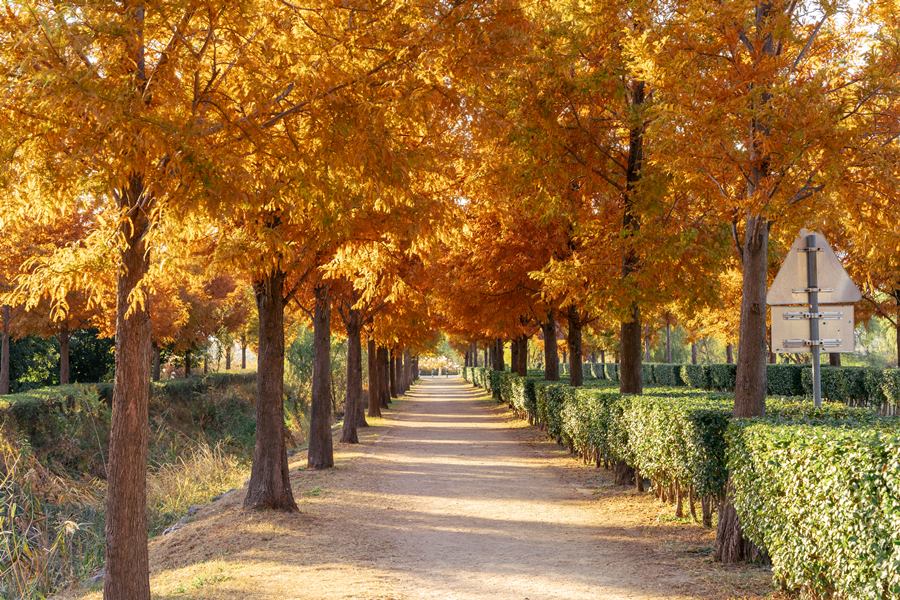 Busan Parks to help citizens make the most of the city’s green spaces
source: visitbusanBusan Metropolitan City has launched “Busan Parks,” a platform providing comprehensive and up-to-date information on the city’s parks, gardens and related cultural events. The website spotlights parks and green spaces citywide. It is organized into seven major categories: Green City Busan, Park Guide, Garden Guide, Forest and Green Space Guide, Companion Animal Culture Guide, News and Reservations. Now, residents can easily find essential information and the detailed history of Busan’s iconic green spaces. Under the 15-Minute City Initiative, Busan continues to improve the quality of life for all citizens, ensuring accessible urban outdoor spaces for strolling, running and unwinding. Given the steady increase in pet owners, the city has worked to develop dedicated open-air green spaces for companion animals. Visitors can find detailed information within the Companion Animal Culture Guide section, covering everything from the specialized cultural park at Cheolma Neighborhood Park to designated dog playgrounds. This section also streamlines information on the city’s animal registration system and animal protection centers, and includes links to the Busan Companion Animal Welfare and Culture Center website.The Busan Parks website also allows visitors to search parks using filters like district and type. Visitors can learn the official definition of a garden, along with a comprehensive list of private and local gardens across the city. Furthermore, the website showcases Busan’s natural resources, including urban forests, recreational forests, arboretums, and various forest experience zones for children. The Sasang Forest Experience Center is set to open in 2027, offering a range of nature-friendly activities.The News section provides the latest information and announcements about events held at parks and arboretums across the city, as well as operational changes. Additionally, residents can get an overview of various experiences and educational programs, and register through the Reservations page.With the launch of the Busan Parks website, the city aims to share vibrant stories and promote diverse events and programs, enabling citizens to stay informed and make the most of the city’s green spaces and companion animal culture.◎ Busan Parks: www.busan.go.kr/park<Today's Vocabulary - 오늘의 단어>launch: 출시하다 accessible: 이용 가능한 stroll: 산책 unwind: 긴장을 풀다 steady: 꾸준한 companion: 반려 comprehensive: 포괄적인 arboretum: 수목원Editor: Song SoomiCopy Editors: Ryu Hyoseung, Anton J. Mapoy
Busan Parks to help citizens make the most of the city’s green spaces
source: visitbusanBusan Metropolitan City has launched “Busan Parks,” a platform providing comprehensive and up-to-date information on the city’s parks, gardens and related cultural events. The website spotlights parks and green spaces citywide. It is organized into seven major categories: Green City Busan, Park Guide, Garden Guide, Forest and Green Space Guide, Companion Animal Culture Guide, News and Reservations. Now, residents can easily find essential information and the detailed history of Busan’s iconic green spaces. Under the 15-Minute City Initiative, Busan continues to improve the quality of life for all citizens, ensuring accessible urban outdoor spaces for strolling, running and unwinding. Given the steady increase in pet owners, the city has worked to develop dedicated open-air green spaces for companion animals. Visitors can find detailed information within the Companion Animal Culture Guide section, covering everything from the specialized cultural park at Cheolma Neighborhood Park to designated dog playgrounds. This section also streamlines information on the city’s animal registration system and animal protection centers, and includes links to the Busan Companion Animal Welfare and Culture Center website.The Busan Parks website also allows visitors to search parks using filters like district and type. Visitors can learn the official definition of a garden, along with a comprehensive list of private and local gardens across the city. Furthermore, the website showcases Busan’s natural resources, including urban forests, recreational forests, arboretums, and various forest experience zones for children. The Sasang Forest Experience Center is set to open in 2027, offering a range of nature-friendly activities.The News section provides the latest information and announcements about events held at parks and arboretums across the city, as well as operational changes. Additionally, residents can get an overview of various experiences and educational programs, and register through the Reservations page.With the launch of the Busan Parks website, the city aims to share vibrant stories and promote diverse events and programs, enabling citizens to stay informed and make the most of the city’s green spaces and companion animal culture.◎ Busan Parks: www.busan.go.kr/park<Today's Vocabulary - 오늘의 단어>launch: 출시하다 accessible: 이용 가능한 stroll: 산책 unwind: 긴장을 풀다 steady: 꾸준한 companion: 반려 comprehensive: 포괄적인 arboretum: 수목원Editor: Song SoomiCopy Editors: Ryu Hyoseung, Anton J. Mapoy
-
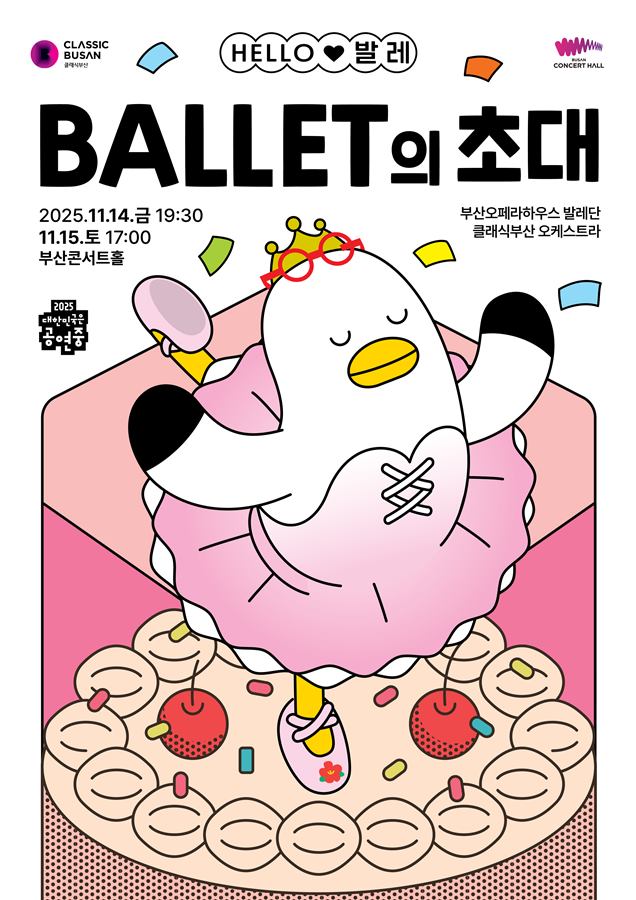 Busan Concert Hall invites you to its first ballet gala concert
The Busan Concert Hall will stage its first ballet gala concert, titled “Hello Ballet: An Invitation to Ballet,” on Nov. 14 and 15.The performance brings together the elegance and virtuosity of the Busan Opera House Ballet Company and the rich, beautiful sound of Classic Busan’s 55-piece orchestra.“Hello Ballet: An Invitation to Ballet” is a repertory show featuring pieces from well-known works such as “Spartacus,” “Swan Lake,” “Paquita” and “The Nutcracker.” Audiences will also be treated to an original work by the Busan Opera House Ballet Company called “Shining Wave.”During the program, Joo Won Kim, the artistic director of the ballet company and a former prima ballerina of the Korean National Ballet, will provide commentary on the featured works.The first performance on Nov. 14 begins at 7:30 p.m., while the show on Nov. 15 starts at 5 p.m. All tickets cost 30,000 won and are available for purchase via the Busan Concert Hall website.※ “Hello Ballet: An Invitation to Ballet,” Nov 14 and 15◎ Busan Concert Hall: 250 Dongpyeong-ro, Busanjin-guDates and Times: Nov. 14, 7:30 p.m. / Nov. 15, 5 p.m. Price: All seats 30,000 won◎ Tickets: Click <Today's Vocabulary - 오늘의 단어>virtuosity: 기교 audience: 관중 commentary: 해설 purchase: 구매하다Editor: Song SoomiCopy Editors: Ryu Hyoseung, Anton J. Mapoy
Busan Concert Hall invites you to its first ballet gala concert
The Busan Concert Hall will stage its first ballet gala concert, titled “Hello Ballet: An Invitation to Ballet,” on Nov. 14 and 15.The performance brings together the elegance and virtuosity of the Busan Opera House Ballet Company and the rich, beautiful sound of Classic Busan’s 55-piece orchestra.“Hello Ballet: An Invitation to Ballet” is a repertory show featuring pieces from well-known works such as “Spartacus,” “Swan Lake,” “Paquita” and “The Nutcracker.” Audiences will also be treated to an original work by the Busan Opera House Ballet Company called “Shining Wave.”During the program, Joo Won Kim, the artistic director of the ballet company and a former prima ballerina of the Korean National Ballet, will provide commentary on the featured works.The first performance on Nov. 14 begins at 7:30 p.m., while the show on Nov. 15 starts at 5 p.m. All tickets cost 30,000 won and are available for purchase via the Busan Concert Hall website.※ “Hello Ballet: An Invitation to Ballet,” Nov 14 and 15◎ Busan Concert Hall: 250 Dongpyeong-ro, Busanjin-guDates and Times: Nov. 14, 7:30 p.m. / Nov. 15, 5 p.m. Price: All seats 30,000 won◎ Tickets: Click <Today's Vocabulary - 오늘의 단어>virtuosity: 기교 audience: 관중 commentary: 해설 purchase: 구매하다Editor: Song SoomiCopy Editors: Ryu Hyoseung, Anton J. Mapoy
Views
-
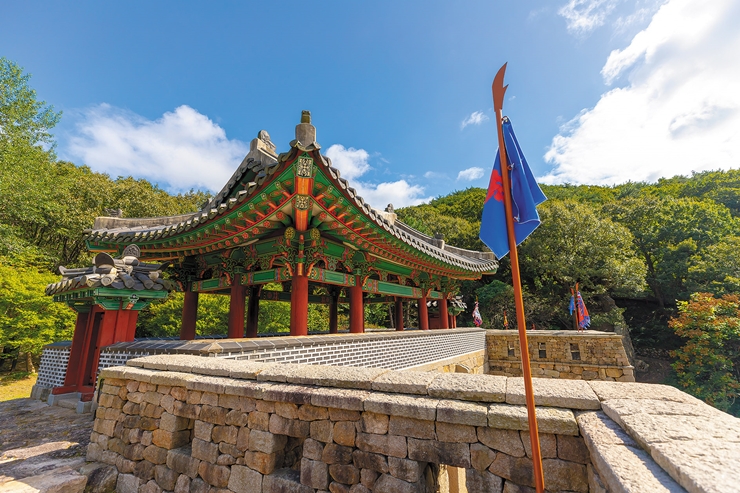욜로코스10서문_이민재(상단하늘합성).jpg&fileext=jpg&filetype=image/jpeg&filesize=381918) An inviting fortress atop Busan's tallest mountain
The YOLO Galmaetgil Trails invite visitors to experience scenic hikes along the city's natural and cultural resources. "YOLO" reflects both "you only live once" and the local dialect for "come here," blending global and regional meaning. Taken together, YOLO is an invitation for visitors to experience the joie de vivre locals have: Come to Busan and enjoy life.Geumjeongsanseong Fortress■ YOLO Route 10 Route 10, fondly known as "Picnic at Geumjeongsanseong Fortress," is a scenic 10-kilometer trail stretching from Gupo Station to Geumjeongsanseong Village. Geumbit Noeul Bridge The first highlight is Geumbit Noeul Bridge, where fiery skies dip over the Nakdonggang River. By day, it links bustling Gupo Market to tranquil Hwamyeong Eco Park; by night, colorful lights create a romantic backdrop for evening strolls.Hwamyeong Eco ParkThe glasshouse at Hwamyeong Arboretum Hwamyeong Eco Park shines in autumn, with rows of golden-brown metasequoias, and swaying silver grass. Nearby, Hwamyeong Arboretum - Busan's first public arboretum - displays themed gardens and seasonal wildflowers.Geumjeongsanseong Village The route continues to the western gate of Geumjeongsanseong Fortress, Korea's largest mountain stronghold, before ending at Geumjeongsanseong Village. Here, visitors savor local delicacies like black goat bulgogi and Sanseong Makgeolli.YOLO Guide : Click
An inviting fortress atop Busan's tallest mountain
The YOLO Galmaetgil Trails invite visitors to experience scenic hikes along the city's natural and cultural resources. "YOLO" reflects both "you only live once" and the local dialect for "come here," blending global and regional meaning. Taken together, YOLO is an invitation for visitors to experience the joie de vivre locals have: Come to Busan and enjoy life.Geumjeongsanseong Fortress■ YOLO Route 10 Route 10, fondly known as "Picnic at Geumjeongsanseong Fortress," is a scenic 10-kilometer trail stretching from Gupo Station to Geumjeongsanseong Village. Geumbit Noeul Bridge The first highlight is Geumbit Noeul Bridge, where fiery skies dip over the Nakdonggang River. By day, it links bustling Gupo Market to tranquil Hwamyeong Eco Park; by night, colorful lights create a romantic backdrop for evening strolls.Hwamyeong Eco ParkThe glasshouse at Hwamyeong Arboretum Hwamyeong Eco Park shines in autumn, with rows of golden-brown metasequoias, and swaying silver grass. Nearby, Hwamyeong Arboretum - Busan's first public arboretum - displays themed gardens and seasonal wildflowers.Geumjeongsanseong Village The route continues to the western gate of Geumjeongsanseong Fortress, Korea's largest mountain stronghold, before ending at Geumjeongsanseong Village. Here, visitors savor local delicacies like black goat bulgogi and Sanseong Makgeolli.YOLO Guide : Click
-
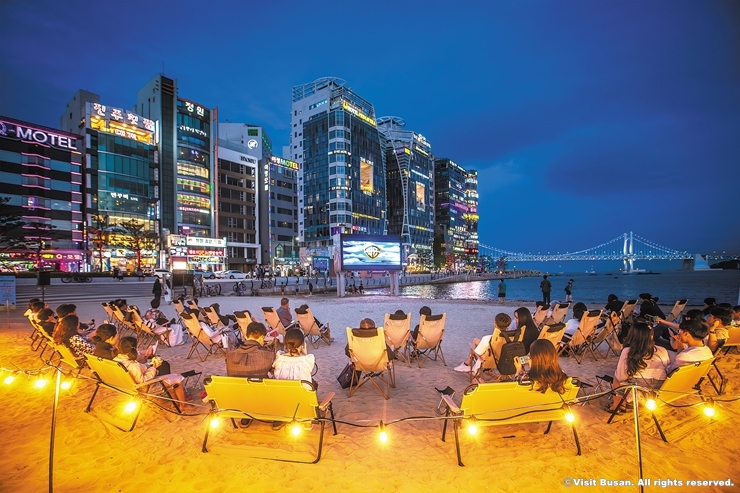.jpg&fileext=jpg&filetype=image/jpeg&filesize=337305) Lights! Coastline! Action!
Busan's YOLO Galmaetgil Trails invite visitors to enjoy life through scenic hikes along the city's natural and cultural resources. "YOLO" reflects both "you only live once" and the local dialect for "come here," blending global and regional meaning. Taken together, YOLO is an invitation for visitors to experience the joie de vivre locals have: Come to Busan and enjoy life.Grab a blanket and enjoy a free movie on Gwangan Beach.The iconic nightscape of Marine City.Fun photo opportunities await on Haeundae Cine Road.Movie screenings at Millak Ocean Cinema cost ₩3,000.Millak Waterside Park is a hot place to enjoy a cool evening.■ YOLO Route 4 Busan's YOLO Galmaetgil Route 4 offers trekkers a cinematic landscape befitting its "Centum Movie Night" nickname. Stretching 4.5 kilometers along the coast, the trail is best enjoyed at night when the city, sea and sky create the perfect mise-en-scene. The plot begins at The Bay 101, where Marine City's skyscrapers glow in mirrored reflections on the water to create an iconic nightscape. From there, the path leads to Haeundae Cine Road, an open-air gallery celebrating Korean cinema with film-inspired art and photographs. Continuing past the Suyeongman Bay Yachting Center, walkers arrive at Millak Waterside Park, a popular spot to relax and view the Gwangandaegyo Bridge. Here, Millak Ocean Cinema stages outdoor movie screenings on weekends, with a floating screen set against the bridge's dazzling backdrop. Nearby, Gwangalli Beach Cinema offers free Friday night films by the sea.Learn more : Click
Lights! Coastline! Action!
Busan's YOLO Galmaetgil Trails invite visitors to enjoy life through scenic hikes along the city's natural and cultural resources. "YOLO" reflects both "you only live once" and the local dialect for "come here," blending global and regional meaning. Taken together, YOLO is an invitation for visitors to experience the joie de vivre locals have: Come to Busan and enjoy life.Grab a blanket and enjoy a free movie on Gwangan Beach.The iconic nightscape of Marine City.Fun photo opportunities await on Haeundae Cine Road.Movie screenings at Millak Ocean Cinema cost ₩3,000.Millak Waterside Park is a hot place to enjoy a cool evening.■ YOLO Route 4 Busan's YOLO Galmaetgil Route 4 offers trekkers a cinematic landscape befitting its "Centum Movie Night" nickname. Stretching 4.5 kilometers along the coast, the trail is best enjoyed at night when the city, sea and sky create the perfect mise-en-scene. The plot begins at The Bay 101, where Marine City's skyscrapers glow in mirrored reflections on the water to create an iconic nightscape. From there, the path leads to Haeundae Cine Road, an open-air gallery celebrating Korean cinema with film-inspired art and photographs. Continuing past the Suyeongman Bay Yachting Center, walkers arrive at Millak Waterside Park, a popular spot to relax and view the Gwangandaegyo Bridge. Here, Millak Ocean Cinema stages outdoor movie screenings on weekends, with a floating screen set against the bridge's dazzling backdrop. Nearby, Gwangalli Beach Cinema offers free Friday night films by the sea.Learn more : Click
-
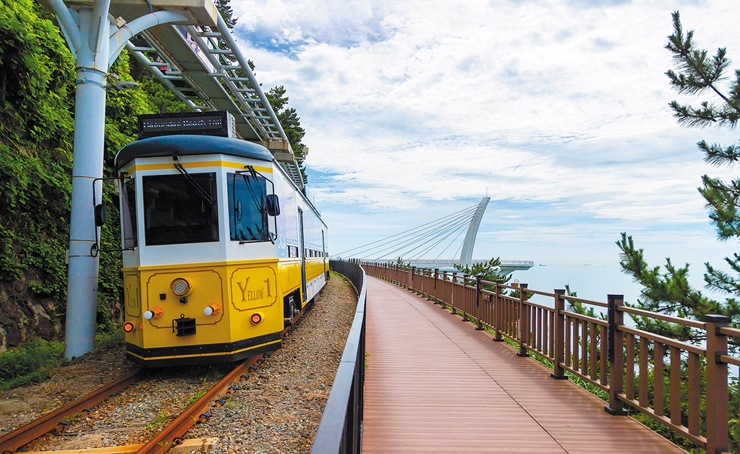 Seaside serenity on the Blue Line
Busan's YOLO Galmaetgil Trails are beloved hiking routes that showcase the city's natural resources and cultural offerings. YOLO has two sources of inspiration. First, from "you only live once," the acronym that describes the mindset that life should be enjoyed; second, from the phrase "come here" as pronounced in the local dialect. Taken together, YOLO invites visitors to experience the joie de vivre locals have: Come to Busan and enjoy life.A retro train, lush forest and ocean views can be found on YOLO Galmaetgil Route 3.Songjeong Beach is the birthplace of Korea's surf culture.A wooden deck runs along Busan돴s eastern coast, side-by-side with trains from the Haeundae Blue Line.Haewol Observatory.Cheongsapo Daritdol Observatory.■ YOLO Route 3 For a refreshing seaside stroll with sweeping ocean views, YOLO Galmaetgil Route 3 offers one of Busan's most picturesque escapes. This scenic 5.8-kilometer route stretches from Songjeong Station to Mipo Station, hugging the city's eastern coastline. A 10-minute walk from Songjeong Station leads to Songjeong Beach. This sandy playground is a favorite year-round, but it buzzes in August with sunseekers and surfers alike. From the beach, trekkers follow a wooden deck that winds along the coast. With brilliant blue water on one side and lush greenery on the other, it's easy to appreciate this urban paradise. Midway through, take a breather at the Cheongsapo Daritdol or Haewol observatories. Their reinforced glass floors offer a heart-pounding view of the waves crashing below. With the sea swirling beneath your feet, either place offers a memorable spot to take a picture and rest before finishing the trail.YOLO Guide : Click
Seaside serenity on the Blue Line
Busan's YOLO Galmaetgil Trails are beloved hiking routes that showcase the city's natural resources and cultural offerings. YOLO has two sources of inspiration. First, from "you only live once," the acronym that describes the mindset that life should be enjoyed; second, from the phrase "come here" as pronounced in the local dialect. Taken together, YOLO invites visitors to experience the joie de vivre locals have: Come to Busan and enjoy life.A retro train, lush forest and ocean views can be found on YOLO Galmaetgil Route 3.Songjeong Beach is the birthplace of Korea's surf culture.A wooden deck runs along Busan돴s eastern coast, side-by-side with trains from the Haeundae Blue Line.Haewol Observatory.Cheongsapo Daritdol Observatory.■ YOLO Route 3 For a refreshing seaside stroll with sweeping ocean views, YOLO Galmaetgil Route 3 offers one of Busan's most picturesque escapes. This scenic 5.8-kilometer route stretches from Songjeong Station to Mipo Station, hugging the city's eastern coastline. A 10-minute walk from Songjeong Station leads to Songjeong Beach. This sandy playground is a favorite year-round, but it buzzes in August with sunseekers and surfers alike. From the beach, trekkers follow a wooden deck that winds along the coast. With brilliant blue water on one side and lush greenery on the other, it's easy to appreciate this urban paradise. Midway through, take a breather at the Cheongsapo Daritdol or Haewol observatories. Their reinforced glass floors offer a heart-pounding view of the waves crashing below. With the sea swirling beneath your feet, either place offers a memorable spot to take a picture and rest before finishing the trail.YOLO Guide : Click



![[Study with Daily Busan] Speak of the devil thumbnail](/ImagePrint.do?dir=smartEditor&savename=4f8109dcfaff437c81017b7d758f4eea&realname=speakofthedevil-001.jpg&fileext=jpg&filetype=image/jpeg&filesize=51541)




